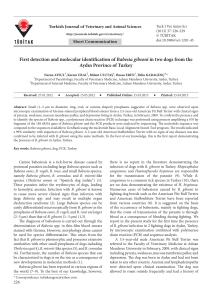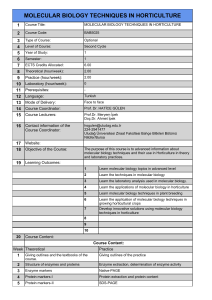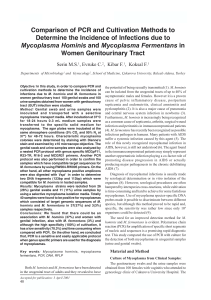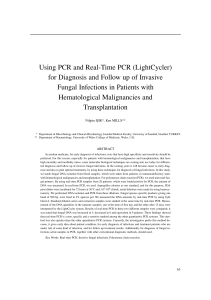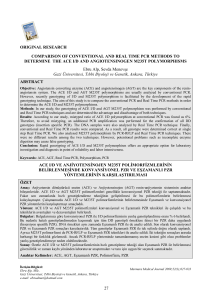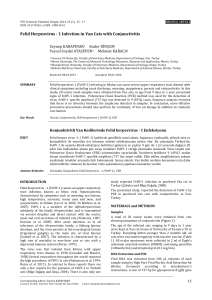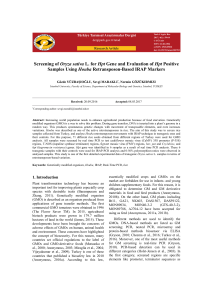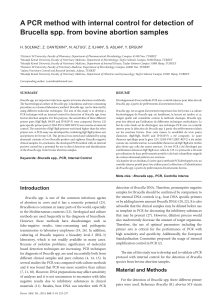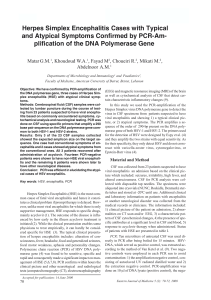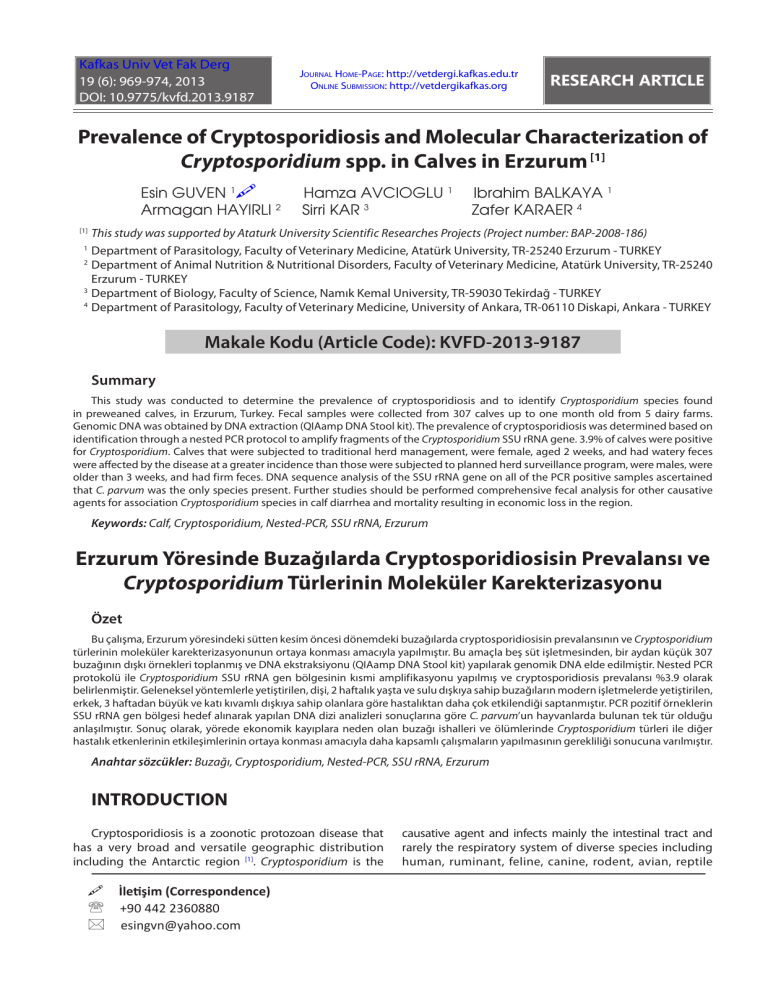
Kafkas Univ Vet Fak Derg
19 (6): 969-974, 2013
DOI: 10.9775/kvfd.2013.9187
Journal Home-Page: http://vetdergi.kafkas.edu.tr
Online Submission: http://vetdergikafkas.org
RESEARCH ARTICLE
Prevalence of Cryptosporidiosis and Molecular Characterization of
Cryptosporidium spp. in Calves in Erzurum [1]
Esin GUVEN 1
Armagan HAYIRLI 2
Hamza AVCIOGLU 1
Sirri KAR 3
Ibrahim BALKAYA 1
Zafer KARAER 4
This study was supported by Ataturk University Scientific Researches Projects (Project number: BAP-2008-186)
Department of Parasitology, Faculty of Veterinary Medicine, Atatürk University, TR-25240 Erzurum - TURKEY
2
Department of Animal Nutrition & Nutritional Disorders, Faculty of Veterinary Medicine, Atatürk University, TR-25240
Erzurum - TURKEY
3
Department of Biology, Faculty of Science, Namık Kemal University, TR-59030 Tekirdağ - TURKEY
4
Department of Parasitology, Faculty of Veterinary Medicine, University of Ankara, TR-06110 Diskapi, Ankara - TURKEY
[1]
1
Makale Kodu (Article Code): KVFD-2013-9187
Summary
This study was conducted to determine the prevalence of cryptosporidiosis and to identify Cryptosporidium species found
in preweaned calves, in Erzurum, Turkey. Fecal samples were collected from 307 calves up to one month old from 5 dairy farms.
Genomic DNA was obtained by DNA extraction (QIAamp DNA Stool kit). The prevalence of cryptosporidiosis was determined based on
identification through a nested PCR protocol to amplify fragments of the Cryptosporidium SSU rRNA gene. 3.9% of calves were positive
for Cryptosporidium. Calves that were subjected to traditional herd management, were female, aged 2 weeks, and had watery feces
were affected by the disease at a greater incidence than those were subjected to planned herd surveillance program, were males, were
older than 3 weeks, and had firm feces. DNA sequence analysis of the SSU rRNA gene on all of the PCR positive samples ascertained
that C. parvum was the only species present. Further studies should be performed comprehensive fecal analysis for other causative
agents for association Cryptosporidium species in calf diarrhea and mortality resulting in economic loss in the region.
Keywords: Calf, Cryptosporidium, Nested-PCR, SSU rRNA, Erzurum
Erzurum Yöresinde Buzağılarda Cryptosporidiosisin Prevalansı ve
Cryptosporidium Türlerinin Moleküler Karekterizasyonu
Özet
Bu çalışma, Erzurum yöresindeki sütten kesim öncesi dönemdeki buzağılarda cryptosporidiosisin prevalansının ve Cryptosporidium
türlerinin moleküler karekterizasyonunun ortaya konması amacıyla yapılmıştır. Bu amaçla beş süt işletmesinden, bir aydan küçük 307
buzağının dışkı örnekleri toplanmış ve DNA ekstraksiyonu (QIAamp DNA Stool kit) yapılarak genomik DNA elde edilmiştir. Nested PCR
protokolü ile Cryptosporidium SSU rRNA gen bölgesinin kısmi amplifikasyonu yapılmış ve cryptosporidiosis prevalansı %3.9 olarak
belirlenmiştir. Geleneksel yöntemlerle yetiştirilen, dişi, 2 haftalık yaşta ve sulu dışkıya sahip buzağıların modern işletmelerde yetiştirilen,
erkek, 3 haftadan büyük ve katı kıvamlı dışkıya sahip olanlara göre hastalıktan daha çok etkilendiği saptanmıştır. PCR pozitif örneklerin
SSU rRNA gen bölgesi hedef alınarak yapılan DNA dizi analizleri sonuçlarına göre C. parvum’un hayvanlarda bulunan tek tür olduğu
anlaşılmıştır. Sonuç olarak, yörede ekonomik kayıplara neden olan buzağı ishalleri ve ölümlerinde Cryptosporidium türleri ile diğer
hastalık etkenlerinin etkileşimlerinin ortaya konması amacıyla daha kapsamlı çalışmaların yapılmasının gerekliliği sonucuna varılmıştır.
Anahtar sözcükler: Buzağı, Cryptosporidium, Nested-PCR, SSU rRNA, Erzurum
INTRODUCTION
Cryptosporidiosis is a zoonotic protozoan disease that
has a very broad and versatile geographic distribution
including the Antarctic region [1]. Cryptosporidium is the
İletişim (Correspondence)
+90 442 2360880
[email protected]
causative agent and infects mainly the intestinal tract and
rarely the respiratory system of diverse species including
human, ruminant, feline, canine, rodent, avian, reptile
970
Prevalence of Cryptosporidiosis and ...
and fish. Transmission usually occurs through the direct
fecal-oral route or through ingestion of water or food
contaminated with oocysts [2,3].
Bovines are the most common species of mammals,
infected with Cryptosporidium and considered the major
reservoir of Cryptosporidium for human infections [3].
Cryptosporidiosis in cattle is mainly caused by C. parvum,
C. andersoni, C. bovis and C. ryanae [2,3]. At least 10 other
Cryptosporidium species or genotypes such as C. felis, C.
meleagridis and C. suis can also play role in etiology [4,5].
Bovine cryptosporidiosis is considered one of the most
common causes of neonatal diarrhea in cattle, leading to
economic losses. The severity of infection ranges from mild
to severe depending on Cryptosporidium species as well
as age, previous exposure and immune status of the host.
Asymptomatic infection is common in yearling heifers
and mature cows [6,7].
Cryptosporidium parvum is a zoonotic species and the
predominant in preweaned calves, especially those at age
of 1-4 weeks [8]. The agent is responsible for about 85% of
cryptosporidiosis in preweaned calves but only 1% of the
disease in postweaned calves and 1-2 year old heifers [6,9,10].
Among the other bovine species, C. bovis and C. ryanae
were detected mainly in weaned calves, and C. andersoni in
yearlings and adult cattle [9,11,12]. While C. bovis and C. ryanae
are considered non-zoonotic, C. andersoni has recently been
reported in few research involving humans in England [13].
The specific diagnosis of Cryptosporidium species
is central to the control of the disease and to the
understanding of the epidemiology. Lack of distinctive
morphologic features of Cryptosporidium oocysts makes
microscopical examination inconvenient in order to clearly
differentiate species and genotypes [14]. Traditionally, C.
parvum has been diagnosed by microscopy of fecal smears,
with or without staining. However, two other species, C.
bovis and C. ryanae, with similar oocyst morphology to C.
parvum, can only be identified using DNA analysis. That
is, microscopy cannot distinguish these three species [6].
Therefore, molecular analyses are required to detect and
distinguish Cryptosporidium at species/genotype and
subtype levels [3,14]. The most frequently used marker for
Cryptosporidium species and genotype identification is the
small subunit of ribosomal RNA (SSU-rRNA) gene [3].
The disease in calves has been studied in many
countries, with prevalence ranging from 2.4 to 100% [3,7].
In Turkey, cryptosporidiosis was first diagnosed in calves
in 1984 [15]. Since then, other surveys have revealed the
prevalence of 7.2-63.9% in calves [16,17]. Most of the studies
carried out in Turkey were based on microscopy of stained
oocysts in feces [15,16,18-21]. Enzyme-linked immunosorbent
assay (ELISA) [17,22] and PCR technique [23-25] have recently
become more common to attain the prevalence of
cryptosporidiosis. However, few studies have coped with
genetic structure of Cryptosporidium species in Turkey [26-28].
This study was conducted to determine the prevalence
of cryptosporidiosis and to characterize Cryptosporidium
species based on PCR amplification and sequence analysis
of SSU rRNA gene in younger than 1-month-old calves in
Erzurum province, Turkey.
MATERIAL and METHODS
Sample Collection
A total of 307 fecal samples were collected from calves
less than 1 month old in dairy farms (herd size ranging
from 100 to 350 Brown Swiss, and Holstein cows in 3
professional dairy farms and from 40 to 85 Brown Swiss,
crossbreed, and Anatolian Red cows in 2 traditional dairy
farms) located in Erzurum province between April-2010
and October-2010. Samples were collected directly from
the rectum with a gloved hand and transferred into a
plastic cup. Fecal consistency was scored as firm, well
formed, loose and diarrheic. Samples were kept at 4°C until
laboratory analyses.
The study protocol was approved by the Animal Care
and Use Committee at Ataturk University (4.4.2008-2008/8
decision number).
DNA Extraction and PCR Amplification
Oocysts were washed and concentrated from feces [29,30]
prior to DNA isolation using a QIAamp DNA Stool kit
(Qiagen, Maryland, USA). Before eluting, aliquots were
added with 100 ml Buffer AE and stored at 20°C.
A nested PCR for the amplification of a fragment of
SSU rRNA gene was performed using the protocols and
primers as described by Xiao et al.[31] with the following
modifications: At the first step of nested PCR, approximately
1.325 bp PCR product was amplified using primers 5’TTCTAGAGCTAATACATGCG-3’ and 5’-CCCATTTCCTTCGAAA
CAGGA-3’. The PCR contained 1x PCR buffer, 6 mM MgCl2,
0.2 mM (each) dNTP, 200 nM (each) primer, 0.025 U of Taq
DNA polymerase, and 1.5 µl of DNA template in a total 25
µl reaction mixture. A total of 35 cycles were carried out at
94°C for 45 s, 55°C for 45 s and 72°C for 1 min. There was also
an initial hot start at 94°C for 3 min and a final extension
at 72°C for 7 min. A secondary PCR was then performed to
amplify 826-864 bp from 1 µl of the primary PCR mixture
using primers 5’-GGAAGGGTTGTATTTATTAGATAAAG-3’ and
5’-AAGGAGTAAGGAACAACCTCCA-3’. The PCR and cycling
conditions were identical to the primary PCR. Amplification
products were separated by electrophoresis on 1% (w/v)
agarose gels, and visualized by ethidium bromide staining.
DNA Sequence Analysis and Phylogenetic Analysis
Successfully amplified samples were subjected to DNA
sequence analysis for species determination. Sequencing
971
GUVEN, AVCIOGLU, BALKAYA
HAYIRLI, KAR, KARAER
was performed using the ABI PRISM® BigDye terminator
cycle sequencing kit in ABI PRISM 310 genetic analyzer
(Applied Biosystems, Foster City, CA). Sequence data
were then subjected to BLASTN (RefSeq) searches of the
Cryptosporidium genome database at the National Center
for Biotechnology Information (http://www.ncbi nlm.nih.
gov/). All sequence data were edited using BioEdit 7.0 (http:
//www.mbio.ncsu.edu/BioEdit/bioedit.html) and FinchTV
Version 1.4.0 (http://www.geospiza.com/finchtv) following
naked eye checking. Multiple sequence alignments were
made with the Clustal W method with BioEdit 7.0 software [32].
The neighbor-joining (NJ) method as implemented in
the MEGA5.1 program [33] was used for the phylogenetic
analysis based on SSU rRNA, utilizing Eimeria tenella
sequence (HQ680474) as out-group. The branch reliability
was assessed by the bootstrap method with 1000
replications.
Table 1. Factors affecting cryptosporidiosis in calves younger than one
month in Erzurum (n=307) *
Tablo 1. Erzurum yöresinde bir aydan küçük buzağılarda cryptosporidiosise
etki eden faktörler (n=307) *
Variable
PCR – (n = 295, 96.09%) PCR + (n = 12, 3.91%)
Enterprise
Traditional
(n=106, 34.53%)
97 (91.5)
9 (8.5)
Professional
(n=201, 65.47%)
198 (98.5)
3 (1.5)
X2 = 9.05, P<0.003
Breed
Culture
(n=264, 85.99%)
Data Analysis
The PROC MEANS and FREQ were computed to obtain
descriptive statistics [34]. Animals were categorized by
breed (culture, crossbreed and local), age (1-7, 8-15 and
16-30 days) and fecal consistency (firm, well formed, loose
and diarrheic) before establishing cross-tables to reveal
association of risk factors with cryptosporidiosis using
Chi-square. The associations were considered significant
at P<0.05.
252 (95.4)
12 (4.5)
Crossbreed
(n=8, 2.61%)
8 (100)
0
Local
(n=35, 11.40%)
35 (100)
0
X2 = 2.03, P<0.36
Age (d)
RESULTS
1-7
(n=30, 9.77%)
28 (93.3)
2 (6.7)
8-15
(n=71, 23.13%)
62 (87.3)
9 (12.7)
16-30
(n=206, 67.10%)
205 (99.5)
1 (0.5)
X2 = 21.56, P<0.0001
Sex
The nested PCR showed a total of 12 (3.9%) positive
amplfications in 307 fecal samples (Table 1). The
cryptosporidiosis prevalence among calves raised in
modern farm was lower than those raised in farms with
poor infrastructure (1.5 vs. 8.5%, P<0.003). The infection
rate in culture breed was insignificantly higher (4.5%) than
the other breeds. As the age advanced, the frequency of
animals infected by Cryptosporidium increased quadratically,
being the highest among calves aged 8-15 days (P<0.0001).
Cryptosporidiosis was more common in females than
males (6.8 vs. 1.3%, P<0.01). The cryptosporidiosis prevalence
increased with the fecal water content (P<0.0001), 13.6%
in calves with the diarrheic feces and 7.1% in calves with
the loose feces (Table 1).
All PCR-positive isolates in Erzurum were confirmed
to be C. parvum (Fig. 1). The sequences were deposited
into GenBank under accession numbers KC437395 to
KC437406, respectively. C. parvum [GenBank: JN245618,
JQ250804, JX886767, DQ656355, AB513881, JX948126,
JX416362, JQ413434, JQ182993], C. andersoni [GenBank:
JX948125, JX437080], C. bovis [GenBank: JX515546,
JX886773, JN245624] and C. ryanae [GenBank: JX886771,
JN245623] were reference species, whereas E. tenella
(HQ680474) was an out-group reference in comparisons.
Fig. 1 depicts phylogenetic relationship among C. parvum
Infection Status
Female
(n=148, 48.21%)
138 (93.2)
10 (6.8)
Male
(n=159, 51.79%)
157 (98.7)
2 (1.3)
X2 = 6.17, P<0.01
Fecal consistency
Firm
(n=11, 3.58%)
11 (100)
0
Well formed
(181, 58.96%)
181 (100)
0
Loose
(n=56, 18.24%)
52 (92.9)
4 (7.1)
Diarrheic
(n=59, 19.22%)
51 (86.4)
8 (13.6)
X2 = 24.00, P<0.0001
*
Data are n (%)
in Erzurum isolates and the other Cryptosporidium isolates
as inferred by the NJ analysis of the partial SSU rRNA gene
sequences. C. parvum in Erzurum isolates were grouped
into the same clade with respective reference C. parvum
sequences. In the present experiment, the percent identities
were 99.3-100% among C. parvum in Erzurum isolates,
98.7-100% with other C. parvum isolates and 87.8-94%
with other Cryptosporidium species from GenBank.
972
Prevalence of Cryptosporidiosis and ...
Fig 1. Phylogenetic relationship among
Cryptosporidium isolates as inferred by
neighbor-joining analysis of SSU rRNA
nucleotide sequences. The sequence for E.
tenella (HQ680474) was used as an out-group.
Numbers on branches indicate percent
bootstrap values from 1000 replicates. All of
Erzurum isolates were identified as C. parvum
Şekil 1. Cryptosporidium izolatlarının SSU
rRNA gen bölgelerinin nükleotid dizileri baz
alınarak neighbor-joining metodu ile yapılan
filogenetik analizi. E. tenella (HQ680474)
sekansı grup dışı olarak kullanılmıştır. Filogenetik ağaçtaki numaralar 1000 tekrar
sonucu elde edilen bootstrap değerlerini
göstermektedir. Erzurum izolatlarının hepsi
C. parvum olarak tanımlanmıştır
DISCUSSION
The prevalence of cryptosporidiosis in Turkey varies
between 7.2-63.9% in calves [16,17]. To our knowledge, this
study delivered the lowest prevalence rate (3.9%) among
other reports from different locations of Turkey [17,19-22,24,26-28].
The difference could be due to a vast number of factors such
as breed, age, management, environment, and season as
well as diagnostic method [5,7,13]. The low prevalence could
also be caused by spot fecal sampling instead of serial
sampling, which may result in underestimation because of
intermittent oocyst excretion [9,11].
The majority of C. parvum infections appear to be limited
to dairy calves under eight weeks of age [10,35], being highest
in calves up to 1-month-old [7,8,36]. In calves, the highest
infection rates are reported in calves 7-14 days old [7,37],
8-14 days old [4,38] and 8-21 days old [39]. In accordance
with the literature, in the present study, the infection
prevalence was highest in calves aged between 8-15
days (12.7%), followed by those aged 1-7 days (6.7%) and
16-30 days (0.5%).
As previously reported by Trotz-Williams et al.[40] in
Ontario, Canada, by Aysul et al.[26] in Aydın, Turkey and
by Coklin et al.[13] in Prince Edward Island, Canada, C.
parvum was the only species identified in calves less than
1 month old. On the other hand, the absence of C. bovis,
C. andersoni and C. bovis in our study could be a result of
the age group (≤ 1 months) because since C. bovis and C.
ryanae are known to be more prevalent in weaned calves
and C. andersoni in yearlings and adult cattle [6,9,11,12].
Calf diarrhea has a multifactorial etiology, and C. parvum
is frequently associated with the disease [7,38,39,41]. Besides,
viruses and bacteria are other causative agents that can
cause this symptom simultaneously or individually. Of 12
C. parvum positive fecal samples, 8 were from diarrheic
calves and 4 from calves with loose feces (Table 1). In
disagreement with some previous studies [35,39,41,42], our
results proved an association of fecal consistency with the
infection. Studies reporting relationship between fecal
consistency and cryptosporidiosis are available [7,12,36].
Because other possible agents were not searched in the
present study, it requires caution to make inference that
973
GUVEN, AVCIOGLU, BALKAYA
HAYIRLI, KAR, KARAER
calves with watery feces are prone to cryptosporidiosis.
Another factor to contribute fecal dry matter is feeding
scheme because looser feces can be consequence of milk
feeding [39]. These suggest that extensive sample analysis
is required to confirm the relationship between fecal
consistency and cryptosporidiosis.
The molecular characterization of Cryptosporidium
species in Turkey has been published in three reports, in
which C. parvum [26-28], C. bovis [27] and C. ryanae [27] were
identified. In our study, homology search proved that
all isolates in Erzurum were C. parvum. The partial SSU
rRNA gene sequences had 100% similarity to reference
sequences downloaded from the GenBank (DQ656355,
AB513881, JX948126, JX416362, JQ413434, JQ182993 and
JN245618). The NJ phylogenetic analysis based on the
SSU rRNA (Fig. 1) showed that all sequences of C. parvum
in Erzurum isolates clustered in the intestinal clade with
reference C. parvum sequences (bootstrap value 92).
In conclusion, the current study elucidated the prevalence
of cryptosporidiosis and the molecular characterization
of Cryptosporidium species found in calves in Erzurum,
Turkey. The prevalence of Cryptosporidium infection in dairy
calves determined by nested PCR was at 3.9%. C. parvum
was the only causative Cryptosporidium species in calves
younger than 1 month in Erzurum province as ascertained
by sequencing the amplified SSU rRNA regions.
Acknowledgements
The authors thank Mehmet Özkan Timurkan for
technical assistance.
REFERENCES
1. Fredes F, Díaz A, Raffo E, Munoz P: Cryptosporidium spp. oocysts
detected using acid-fast stain in feces of gentoo penguins (Pygoscelis
papua) in Antarctica. Antarct Sci, 20, 495-496, 2008.
2. Fayer R: Taxonomy and species delimitation in Cryptosporidium. Exp
Parasitol, 124, 90-97, 2010.
3. Xiao L: Molecular epidemiology of cryptosporidiosis: An update. Exp
Parasitol, 124, 80-89, 2010.
4. Imre K, Lobo LM, Matosb O, Popescu C, Genchid C, Darabus G:
Molecular characterisation of Cryptosporidium isolates from pre-weaned
calves in Romania: Is there an actual risk of zoonotic infections? Vet
Parasitol, 181, 321-324, 2011.
5. Venu R, Latha BR, Basith SA, Raj GD, Sreekumar C, Raman M:
Molecular prevalence of Cryptosporidium spp. in dairy calves in Southern
states of India. Vet Parasitol, 188, 19-24, 2012.
6. Silverlås C, Näslund K, Björkman C, Mattsson G: Molecular
characterization of Cryptosporidium isolates from Swedish dairy cattle in
relation to age, diarrhoea and region. Vet Parasitol, 169, 289-295, 2010.
7. Díaz-Lee A, Mercado R, Onuoha EO, Ozaki LS, Munoz P, Munoz
V, Martínez FJ, Fredes F: Cryptosporidium parvum in diarrheic calves
detected by microscopy and identified by immunochromatographic and
molecular methods. Vet Parasitol, 176, 139-144, 2011.
8. Starkey SR, Wade SE, Schaaf S, Mohammed HO: Incidence of
Cryptosporidium parvum in the dairy cattle population in a New York City
watershed. Vet Parasitol, 131, 197-205, 2005.
9. Santín M, Trout JM, Fayer R: A longitudinal study of cryptosporidiosis in
dairy cattle from birth to two years of age. Vet Parasitol, 155, 15-23, 2008.
10. Brook E, Hart CA, French N, Christley R: Molecular epidemiology of
Cryptosporidium subtypes in cattle in England. Vet J, 179, 378-382, 2009.
11. Fayer R, Santín M, Trout JM, Greiner E: Prevalence of species and
genotypes of Cryptosporidium found in 1-2-year-old dairy cattle in the
eastern United States. Vet Parasitol, 135, 105-112, 2006.
12. Fayer R, Santín M, Trout JM: Prevalence of Cryptosporidium species
and genotypes in mature dairy cattle on farms in eastern United States
compared with younger cattle from the same locations. Vet Parasitol, 145,
260-266, 2007.
13. Coklin T, Uehlinger FD, Farber JM, Barkema HW, O’Handley RM,
Dixon BR: Prevalence and molecular characterization of Cryptosporidium
spp. in dairy calves from 11 farms in Prince Edward Island, Canada. Vet
Parasitol, 160, 323-326, 2009.
14. Jex AR, Smith HV, Monis PT, Campbell BE, Gasser RB:
Cryptosporidium-Biotechnological advances in the detection, diagnosis
and analysis of genetic variation. Biotechnol Adv, 26, 304-317, 2008.
15. Burgu A: Türkiye’de buzağılarda Cryptosporidium’ların bulunuşu ile
ilgili ilk çalışmalar. Ankara Üniv Vet Fak Derg, 31 (3): 573-585, 1984.
16. Özer E, Erdoğmuş SZ, Köroğlu E: Elazığ yöresinde buzağı ve
kuzularda bulunan Cryptosporidium’un yayılışı üzerinde araştırmalar.
Doğa Turk J Vet Anim Sci, 14, 439-445, 1990.
17. Sevinç F, Irmak K, Sevinç M: The prevalence of Cryptosporidium
parvum infection in the diarrhoeic and non-diarrhoeic calves. Revue Med
Vet, 154 (5): 357-361, 2003.
18. Özlem MB, Eren H, Kaya O: Aydın yöresi buzağılarında Cryptosporidium’
ların varlığının araştırılması. Bornova Vet Kontr Araşt Enst Md Derg, 22 (36):
15-22, 1997.
19. Değerli S, Çeliksöz A, Kalkan K, Özçelik S: Prevalence of
Cryptosporidium spp. and Giardia spp. in cows and calves in Sivas. Turk J
Vet Anim Sci, 29, 995-999, 2005.
20. Göz Y, Gül A, Aydın A: Hakkari yöresinde sığırlarda Cryptosporidium
sp.’nin yaygınlığı. YYÜ Vet Fak Derg, 18, 37-40, 2007.
21. Aştı C, Özbakış G, Azrug AF, Orkun Ö, Nalbantoğlu S, Çakmak A,
Burgu A: Farklı illere ait buzağı dışkı bakısı sonuçları. Kafkas Univ Vet Fak
Derg, 18 (Suppl-A): A209-A214, 2012.
22. Çiçek M, Körkoca H, Gül A: Van belediyesi mezbahasında çalışan
işçilerde ve kesimi yapılan hayvanlarda Cryptosporidium sp.’nin
araştırılması. T Parazitol Derg, 32 (1): 8-11, 2008.
23. Arslan MÖ, Erdoğan HM, Tanrıverdi S: Neonatal buzağılarda
Cryptosporidiosis’in epidemiyolojisi. 13. Ulusal Parazitoloji Kongresi,
Program ve Özet Kitabı, SB6-01, s. 186, 8-12 Eylül, Konya-TÜRKİYE, 2003.
24. Sungur T, Kar S, Güven E, Aktaş M, Karaer Z, Vatansever Z:
Cryptosporidium spp’nin dışkıdan nested-PCR ve carbol fuchsin boyama
yöntemi ile teşhis edilmesi. T Parazitol Derg, 32 (4): 305-308, 2008.
25. Sakarya Y, Kar S, Tanyüksel M, Karaer Z, Babür C, Vatansever Z:
Detection of Cryptosporidium spp. in humans and calves through nested
PCR and carbol fuchsin staining methods in Ankara, Turkey. Kafkas Univ
Vet Fak Derg, 16 (6): 977-980, 2010.
26. Aysul N, Ulutaş B, Ünlü H, Hoşgör M, Atasoy A, Karagenç T: Aydın
ilinde ishalli buzağılarda bulunan Cryptosporidium türlerinin moleküler
karakterizasyonu. 16. Ulusal Parazitoloji Kongresi, Program ve Özet Kitabı,
S-15, s. 208, 1-7 Kasım, Adana-TÜRKİYE, 2009.
27. Şimşek AT, İnci A, Yıldırım A, Çiloğlu A, Bişkin Z, Düzlü Ö: Nevşehir
yöresinde ishalli buzağılarda Cryptosporidium türlerinin moleküler
prevalansı ve karakterizasyonu. 17. Ulusal Parazitoloji Kongresi, Program ve
Özet Kitabı, SB03-06, s.158, 5-10 Eylül, Kars-TÜRKİYE, 2011.
28. Arslan MÖ, Ekinci Aİ: Kars yöresinde sığırlarda Cryptosporidium
parvum subtiplerinin belirlenmesi. Kafkas Univ Vet Fak Derg, 18 (Suppl-A):
A221-A226, 2012.
29. Fayer R, Morgan U, Upton SJ: Epidemiology of Cryptosporidium:
transmission, detection and identification. Int J Parasitol, 30, 1305-1322,
2000.
30. Santín M, Trout JM, Xiao L, Zhou L, Greiner E, Fayer R: Prevalence
and age-related variation of Cryptosporidium species and genotypes in
974
Prevalence of Cryptosporidiosis and ...
dairy calves. Vet Parasitol, 122, 103-117, 2004.
31. Xiao L, Singh A, Limor J, Graczyk TK, Gradus S, Lal A: Molecular
characterization of Cryptosporidium oocysts in samples of raw surface
water and wastewater. Appl Environ Microb, 67, 1097-1101, 2001.
32. Thompson JD, Gibson TJ, Plewniak F, Jeanmougin F, Higgins
DG: The Clustal X windows interface: Flexible strategies for multiple
sequences alignment aided by quality analysis tools. Nucleic Acids Res, 25,
4876-4882, 1997.
33. Tamura K, Peterson D, Peterson N, Stecher G, Nei M, Kumar
S: MEGA5: Molecular evolutionary genetics analysis using maximum
likelihood, evolutionary distance and maximum parsimony methods. Mol
Biol Evol, 28, 2731-2739, 2011.
34. SAS: Statistical analysis system, User’s Guide, Version 9. SAS Institute
Inc, Cary, NC, 2002.
35. Silverlås C, Bosaeus-Reineck H, Näslund K, Björkman C: 2012.
Is there a need for improved Cryptosporidium diagnostics in Swedish
calves? Int J Parasitol, 43 (2): 155-161, 2013.
36. Maurya PS, Rakesh RL, Pradeep B, Kumar S, Kundu K, Garg R, Ram
H, Kumar A, Banerjee PS: Prevalence and risk factors associated with
Cryptosporidium spp. infection in young domestic livestock in India. Trop
Anim Health Prod, 45 (4): 941-946, 2013.
37. Tanriverdi S, Markovics A, Arslan MO, Itik A, Shklap V, Widmer
G: Emergence of distinct genotypes of Cryptosporidium parvum in
structured host populations. Appl Environ Microbiol, 72, 2507-2513, 2006.
38. de la Fuente R, Luzon M, Ruiz-Santa-Quiteria JA, Garcia A, Cid
D, Orden JA, Garcia S, Sanz R, Gomez-Bautista M: Cryptosporidium
and concurrent infections with other major enterophatogens in 1 to
30-day-old diarrheic dairy calves in central Spain. Vet Parasitol, 80, 179185, 1999.
39. Brook E, Hart CA, French N, Christley R: Prevalence and risk factors
for Cryptosporidium spp. infection in young calves. Vet Parasitol, 152, 4652, 2008.
40. Trotz-Williams LA, Martin DS, Gatei W, Cama V, Peregrine AS,
Martin SW, Nydam DV, Jamieson F, Xiao L: Genotype and subtype
analyses of Cryptosporidium isolates from dairy calves and humans in
Ontario. Parasitol Res, 99, 346-352, 2006.
41. Silverlås C, de Verdier K, Emanuelson U, Mattsson JG, Björkman
C: Cryptosporidium infection in herds with and without calf diarrheal
problems. Parasitol Res, 107, 1435-1444, 2010.
42. Maikai BV, Umoh JU, Kwaga JKP, Lawal IA, Maikai VA, Cama V, Xiao
L: Molecular characterization of Cryptosporidium spp. in native breeds of
cattle in Kaduna State, Nigeria. Vet Parasitol, 178, 241-245, 2011.


